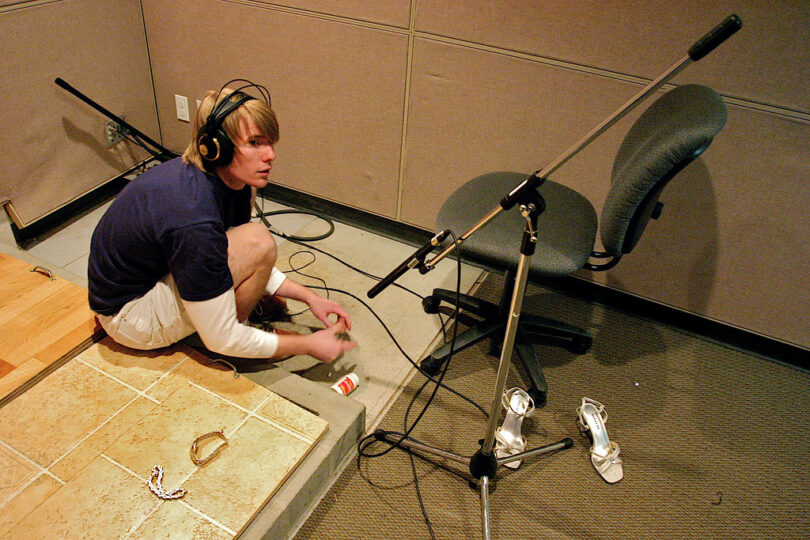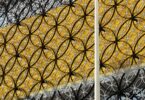The Sonic Symphony is a strange and wonderful art, one few appreciate but which shapes our experience of filmed media. Its incredible complexity creates an immersive soundscape, transporting viewers far beyond the pictures on a screen. Whether it’s a car crash or a peaceful nature scene, without mastering Foley for film and television production, true cinematic emotion wouldn’t exist. What is Foley, and how can one master it for greater impact? Read on to find out.
1. Introduction to Foley Art
Foley art is an exciting craft that enables filmmakers to create captivating soundscapes in the stories they tell. It can also be used to enhance the emotional intensity of a scene and to generate more immersive experiences for audiences. Here’s a look at how to get started crafting your own sonic symphonies for visual media!
- Defining Foley Art and it’s Principles:
- Selecting the Right Foley Recording Equipment
- Getting Ready to Capture Foley Sound Effects
- Recording Foley Audio in Post Production
Defining Foley Art and it’s Principles: Foley art is the craft of re-creating sound effects as they are performed in sync with the visuals in a film or television production. This can be done in-studio with professional sound effects equipment or on-location with handheld tools. Both types of recording can produce high-quality sound effects and enrich the overall audio experience.
The principle behind foley art is to match sound to the visuals, as perfectly as possible. Foley art aims to recreate the same sonic elements that would naturally be present in a scene, such as footsteps, doors closing, background noise, and more. Since this is a creative process, it’s important to pay attention to the emotions or atmosphere that you want to evoke with your sound effects.
Selecting the Right Foley Recording Equipment: When creating your own foley art, it’s important to choose the right recording equipment. Consider your budget, the size of the space you’ll be working in, and the types of sound effects you want to create. For basic foley artwork, a laptop or desktop computer with a microphone and some software program can do the trick. For more professional recordings, though, you’ll need professional sound boards, high-quality microphones, and audio processing software.
Getting Ready to Capture Foley Sound Effects: Before you begin recording, it’s important to plan and prepare for the type of foley art you want to create. Make sure you have a list of all the sound effects you need to recreate, and plan the exact sequence in which they will play. A great foley artist also takes into account environmental factors such as temperature, air pressure, and humidity, as these can affect the auditory quality of sound.
Recording Foley Audio in Post Production: Once your recording equipment is ready and your sound effects are planned, it’s time to get begin recording your foley art. It can help to watch the movie or tv show to get an idea of the pace and timing of the action. It’s also helpful to have a note-taker by your side to ensure you get all the sound effects down correctly. After each recording session, take a few minutes to review your audio and make any necessary adjustments before moving onto the next effect.
Foley art is an art form that all filmmakers should try out – it can help you craft unforgettable audio experiences and take your project to the next level!
2. Uncovering the Secrets of the Sonic Symphony
When it comes to audio effects for film and television, few sound effects can lend as much power and emotion as the sonic symphony. From booming orchestral arrangements to subtle ambient drones, the sonic symphony can evoke a range of emotions and increase tension. Here, we’ll look at the art of mastering the sonic symphony: Foley for film and television.
- Understand the basics: The sonic symphony isn’t magically created; it is the result of a carefully-constructed composition. Foley is the process of creating and recording sound effects to give life to a scene or story. Foley artists use mundane objects to generate a variety of sounds and recreate the sounds of everyday life in the studio.
- Choose the right sounds: The key to creating an effective sonic symphony is to choose the right sounds. Always consider the impact of each sound and how it contributes to the overall effect. Choose sounds that reflect the tone and mood of the scene.
- Record Foley: Once you’ve selected the sound you need, it’s time to record it. Foley is recorded in the studio, so choose the right equipment to capture the best possible sound. Utilise multiple microphones to pick up different aspects of the sound.
- Mix Foley: Finally, mix the Foley to ensure the sounds are cohesive and balanced with the rest of the audio. This is the final step in creating the sonic symphony and is essential for ensuring the best possible effect.
Mastering the sonic symphony for film and television requires a creative and careful approach. With the right tools, techniques and experience, you can create a stunning sonic symphony that adds depth and power to your work.
3. What Goes Into a Foley Session
Foley is the most detailed and subtle sound editing for film and television. It takes an experienced sound technician to master the craft of using Foley sounds in the post-production process. So, ?
- Foley Room: This is an acoustically isolated space with minimal reverberations, which allows great control over the Foley recordings.
- Foley-Mixed Tracks: These are the pre-recorded Foley sounds that have been arranged, mixed, and professionally edited beforehand.
- Foley Artist: The Foley Artist is the person responsible for the performance of all the Foley sounds.
- Prop List: Foley Artists perform each sound using items of different textures, sizes, and weight. They create the sound by manipulating an item until they get the desired effect. A prop list is a list of the items that the Foley Artist will use to create the sounds in their session.
- Microphones: The Foley Artist uses appropriate fine-tuned microphones to obtain the highest quality of sound.
- Mixer and Speakers: Foley is mixed live, so the Foley Artist and sound technician need access to high-quality mixers and speakers.
- Editing & Synthesis Software: Foley sounds can be edited and combined to create even more unique and detailed sound effects. The Foley Artist also uses synthesis software to generate any desired sound.
- Music: As the Foley session is mixed live, musical accompaniment and rhythmic elements can be added to the soundtrack to create a more immersive overall soundscape.
When executed correctly, the combination of these elements into a Foley session helps create an incredibly detailed and captivating aural experience. This is one of the most exciting aspects of sound design, and a real masterstroke for all those involved.
4. Examining the Role of Technology in Foley Art
It is through the use of Foley art that sound designers bring the world of screen media to life. Foley captures, creates and manipulates all the nuances that go into producing a well-crafted sonic narrative experience. It takes a special type of skills, knowledge and creativity to properly capture and create organic sound effects that assist in telling the story. is an invaluable way to gain an understanding of the craft.
Utilizing the tools of modern technology can drastically assist in the production of Foley art. Digital audio software and recording devices have become essential tools for sound designers and foley artists to create multiple layers and complexity to a soundscape. Editing and mixing software, for instance, allow for compositing and remapping techniques in order to blend various sounds into singular, element-rich renditions. Without these tools, Foley art would be unable to achieve the level of complexity it has today.
The incorporation of synthesizers has also revolutionized the way foley is composed. Synthesizers enable sound designers to craft customized sounds from other materials, without ever having to produce them organically. These blends of both electronic and organic components offer a unique way of creating a living and breathing soundscape. Additionally, technologies such as biometrics can be used by sound designers to dynamically control sound design. Such a tool affords dynamically tailored experiences for viewers that conform and change as needed.
In order to master Foley art for film and TV, it is essential to have a combined knowledge of both traditional craft and modern technology. By merging organic audio principles and modern tools, sound designers are able to bring the world of audio engineering to the next level. Through the use of the latest technology, sound designers are able to create a sonic symphony of amazing depth and nuance that can be controlled in real time.
5. Crafting Engaging & Memorable Foley Sounds
Foley is an essential component of audio post-production for film and television. It requires skill and precision to create a sonic symphony of captivating sounds to draw the audience in and visualize the scene in their mind. Here are five tips and tricks for crafting engaging and memorable Foley sounds for your audio projects.
1. Choose the right Foley tools. Selecting the right Foley tools and equipment for your projects is key to creating believable and realistic sounds. Knowing the type of sound you’re trying to create or enhance will help inform your decision. Consider the environment of the scene and the acoustics of the space to ensure a natural sound.
2. Record from different perspectives. Recording the same sound in different perspectives can help create a layered and dimensional sonic experience. Utilize both close and distant mics to capture the nuances of the sound and ultimately make it more believable.
3. Record a variety of sounds. Foley requires creativity and experimentation, so don’t feel confined to recording sounds from the scene. Record and experiment with different objects and environments to create unique sounds. A combination of various elements can often help enhance the sound.
4. Use sampling. Sampling and sound design can be a great way to manipulate and enhance Foley sounds. Consider adding different sonic elements to the sound to create an otherworldly or alien effect. Sampling can also help to create unique soundscapes and atmospheres.
5. Utilize DSP effects. Utilizing digital signal processing (DSP) effects can help to manipulate and enhance a sound. Reverb can help to create a sense of space in a sound, while EQ can help to sculpt the overall frequency of the sound. Experiment with different plugins to find the effect that best suits your needs.
6. Contemporary Foley Trends & Techniques
Creating Believable Listening Experiences with Foley
Modern Foley is a complex creative craft that requires tremendous skill and attention to detail. Top sound designers and mixers understand the importance of crafting Foley effects that perfectly match the action on screen, creating accurate and believable listening experiences for viewers. Here are some of the contemporary Foley trends and approaches that are driving innovation in the post-production space.
Organic Foley
Organic Foley is often associated with signature sounds, like footsteps and clothing rustles. By recording these sounds with unique objects in different settings, Foley artists are creating a much more realistic soundscape that takes viewers deeper into the narrative. By employing organic Foley, audio technicians can craft an immersive soundscape that resonates with viewers and transports them into the characters’ reality.
Adding Textural Elements
Dynamics and texture are also important in Foley. Audio technicans are taking creative approaches to depth and ambience by adding background noises like wind or rain, as well as extra sound effects to add texture and change noises. These subtle effects can often go unnoticed, but they make a big difference in the realism and quality of the audio.
Exploring Digital Foley
The world of Foley is no longer limited to recorded sounds, with audio technicians now exploring the possibilities of digital Foley. Digital Foley enables Foley artists to create an exact sonic representation of the action on screen, giving them a huge amount of creative freedom and allowing them to experiment and explore new soundscapes. With the right software and equipment, Foley artists are now able to accurately recreate any sound imaginable, creating an incredibly realistic and immersive listening experience for viewers.
Integrating Foley with Sound Design
Let’s not forget the importance of synthesizing Foley with sound design. The Foley process needs to be integrated with the work of a sound designer. This is key to creating a cohesive soundscape that flows seamlessly, and helps to give the film or show its own unique sonic identity. By blending Foley and sound design, a superb sonic symphony can be crafted that captures the essence of the story.
7. Strategies for Working with Audio in Film & TV
Foley work can make or break any great piece of cinematic/televisual art. Every audio element, from the sound of an actor’s footsteps to the ring of a blade slashing through the air, plays a role in creating a fully realized soundscape that pulls the viewer in and evokes emotion.
Step 1: Record
Start your Foley session by recording all the audio elements you need. For a scene that takes place outdoors, you may need environmental sounds like rain and birds. For a sword fight, you’ll need sounds for the swords clashing with eachother. Such recordings are the key to part one of the sonic symphony-gathering materials.
Step 2: Layer
Once you have your raw audio elements, the next step in mastering Foley is to layer them. This is the act of combining the elements in different ways to create more nuanced sounds. For example, if you’re creating a forest scene, you can layer bird sounds with a few insect chirps to create a denser forest soundscape.
Step 3: Edit & Mix
Once you have your layers in place, the next step it to edit and mix them. This is where you can start to adjust volume levels and apply equalization to create the desired sonic effect. You can also start to effect the audio with plugins or real-life sound effects like reverb or delay.
Step 4: Finalize
Finally, the last step of the Foley process is to finalize the soundscape. This is where you can make minor tweaks to ensure that the Foley tracks fit perfectly with the rest of the mix. You can also add any last minute effects, like a slight rumble of thunder in the background to give the track more dimension.
The end result of your Foley work should be a rich, immersive soundscape that elevates the audio to the level of art. When done correctly, Foley has the power to transport the viewer into another world, and create a truly memorable aural experience.
8. Conclusion
The journey of Foley artistry has come to a close. Throughout this article, we explored the vast landscape of sound and its role in film and television production. We dug deep into the history of Foley and examined its influence on the overall production process. We also discussed the importance of proper foley recording, mixing, and placement for creating realistic soundscapes.
1) The Basics
We started our journey by going over the basics of foley artistry and its vital role in post-production. We discussed the benefits of recording, mixing, and placing foley cues in the available soundscape. Furthermore, we discussed the steps involved in creating realistic sounds, such as floor creaks, ambient winds, and character movements.
2) The Impact
We moved on to discussing the impact of foley artistry on a project’s overall production. We identified several potential applications for foley in a variety of scenarios, including enhancing dialog, creating a mood, and reinforcing action. We also highlighted the importance of understanding the nuances of foley work and how to properly use and mix it for desired results.
3) The Tools
Next, we discussed the variety of tools used in foley artistry, such as props, sound effects, and environment recordings. We outlined the typical types of props used for administration, along with how environment recordings can enhance the ambience of a project. We also addressed the importance of sound design elements and how they can influence the overall sound of a project.
4) The Process
Finally, we dove into the process of foley artistry, from pre-production to post. We outlined the core steps involved in the task, from preparation to recording, and mixing to placement. We discussed the importance of communication with the rest of the production team and the need for detailed planning. Ultimately, our journey ended with tips for mastering foley and ideas for incorporating it into your projects.
No matter the project’s size or scope, foley artistry is an essential element that adds depth and realism to the audio mix. By understanding the core steps involved in foley artistry, achievement of consistent and realistic demands can be ensured. Through communication with the production team and clear planning, the overall sound of a project can be enhanced with careful foley mixing and placement. With this in mind, it is possible to create a sonic symphony that resonates with audiences. The Sonic Symphony is not an easy job, but when done correctly, it can transport viewers through incredible soundscapes while enriching the overall viewing experience. It takes a master of Foley to know how to accurately recreate and enrich the sonic elements of a film or television series. To experience a harmonious combination of audio bliss and tapestry of perfectly placed sound effects, seek out the work of the masters – they are the masters of the Sonic Symphony.








Leave a Comment